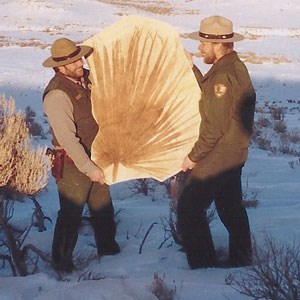
NPS photo. IntroductionThe National Park System contains a magnificent record of geologic time because rocks from each period of the geologic time scale are preserved in park landscapes. No single park has rocks from every geologic period, though some come close. Geologic TimeWith the help of clocks, calendars, and appointment books, we organize our lives around time. We divide time into years, months, weeks, and days. Likewise, geologists created the geologic time scale to organize Earth’s history into eons, eras, periods, and epochs. While a human life spans decades, geologic time spans all of Earth’s history—4,600 million years! Cenozoic EraThe Cenozoic Era (66 million years ago through today) is the "Age of Mammals." Birds and mammals rose in prominence after the extinction of giant reptiles. Common Cenozoic fossils include cat-like carnivores and early horses, as well as ice age fossils like wooly mammoths. Caves can preserve the remains of ice-age animals that died in them or were transported there after death. Learn more and visit parks that preserve Cenozoic fossils:66 MILLION YEARS AGO TO TODAYCenozoic EraMesozoic EraThe Mesozoic Era (252 to 66 million years ago) was the "Age of Reptiles." Dinosaurs, crocodiles, and pterosaurs ruled the land and air. As climate changed, sea levels rose world-wide and seas expanded across the center of North America. Large marine reptiles such as plesiosaurs, along with the coiled-shell ammonites, flourished in these seas. Common Mesozoic fossils include dinosaur bones and teeth, and diverse plant fossils. Learn more and visit parks that preserve Mesozoic fossils:252 MILLION TO 66 MILLION YEARS AGOMesozoic EraPaleozoic EraDuring the Paleozoic Era (541 to 252 million years ago) Fish diversified and marine organisms were very abundant during the Paleozoic. Common Paleozoic fossils include trilobites and cephalopods such as squid, as well as insects and ferns. The greatest mass extinction in Earth's history ended this era. Learn more and visit parks the preserve Paleozoic fossils:541 MILLION TO 252 MILLION YEARS AGOPaleozoic EraThe PrecambrianThe Precambrian (prior to 541 million years ago) was the "Age of Early Life." Soft-bodied creatures like worms and jellyfish lived in the world's oceans. The land remained barren. Common Precambrian fossils include mats of algae called stromatolites, microorganisms, and simple animals. Learn more and visit parks that preserve Precambrian fossils:4.5 BILLION to 541 MILLION YEARS AGOThe Precambrian
|
Last updated: December 11, 2024
